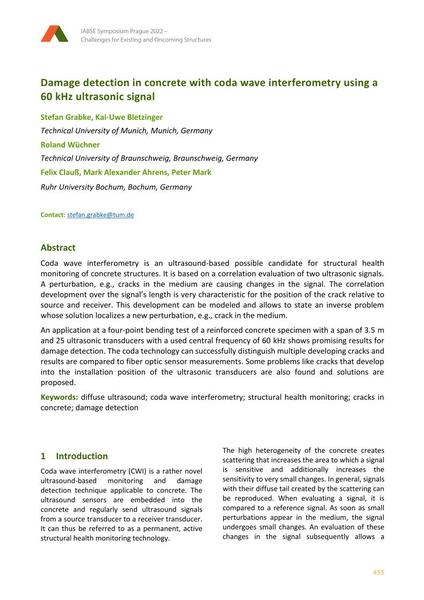Damage detection in concrete with coda wave interferometry using a 60 kHz ultrasonic signal

|
|
|||||||||||
Bibliographic Details
| Author(s): |
Stefan Grabke
(Technical University of Munich, Munich, Germany)
Kai-Uwe Bletzinger (Technical University of Munich, Munich, Germany) Roland Wüchner (Technical University of Braunschweig, Braunschweig, Germany) Felix Clauß (Ruhr University Bochum, Bochum, Germany) Mark Alexander Ahrens Peter Mark (Ruhr University Bochum, Bochum, Germany) |
||||
|---|---|---|---|---|---|
| Medium: | conference paper | ||||
| Language(s): | English | ||||
| Conference: | IABSE Symposium: Challenges for Existing and Oncoming Structures, Prague, Czech Republic, 25-27 May 2022 | ||||
| Published in: | IABSE Symposium Prague 2022 | ||||
|
|||||
| Page(s): | 453-457 | ||||
| Total no. of pages: | 5 | ||||
| DOI: | 10.2749/prague.2022.0453 | ||||
| Abstract: |
Coda wave interferometry is an ultrasound-based possible candidate for structural health monitoring of concrete structures. It is based on a correlation evaluation of two ultrasonic signals. A perturbation, e.g., cracks in the medium are causing changes in the signal. The correlation development over the signal’s length is very characteristic for the position of the crack relative to source and receiver. This development can be modeled and allows to state an inverse problem whose solution localizes a new perturbation, e.g., crack in the medium. An application at a four-point bending test of a reinforced concrete specimen with a span of 3.5 m and 25 ultrasonic transducers with a used central frequency of 60 kHz shows promising results for damage detection. The coda technology can successfully distinguish multiple developing cracks and results are compared to fiber optic sensor measurements. Some problems like cracks that develop into the installation position of the ultrasonic transducers are also found and solutions are proposed. |
||||
| Keywords: |
structural health monitoring coda wave interferometry damage detection diffuse ultrasound cracks in concrete
|
||||
| Copyright: | © 2022 International Association for Bridge and Structural Engineering (IABSE) | ||||
| License: | This creative work is copyrighted material and may not be used without explicit approval by the author and/or copyright owner. |
||||
